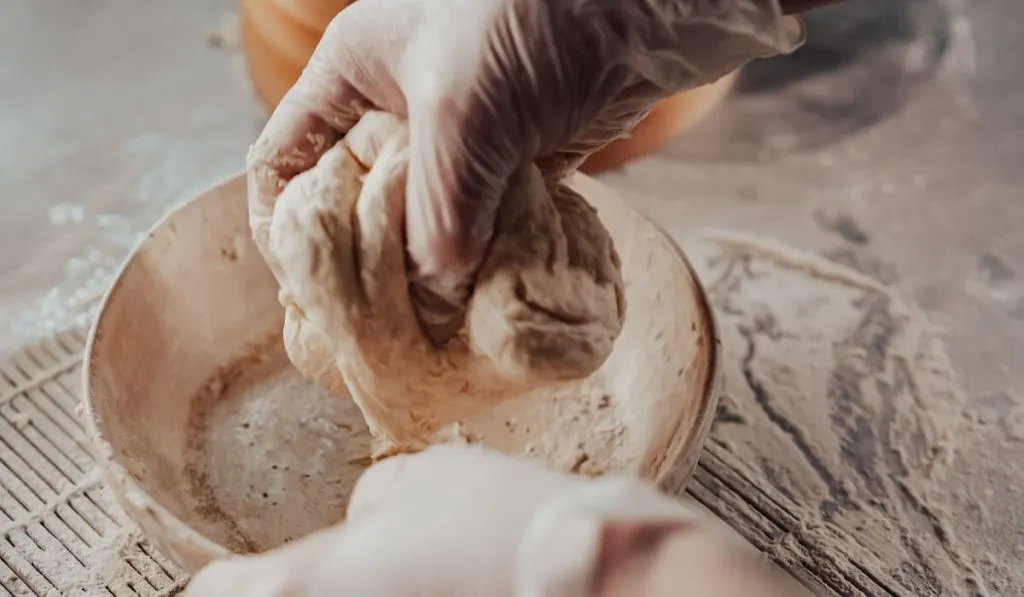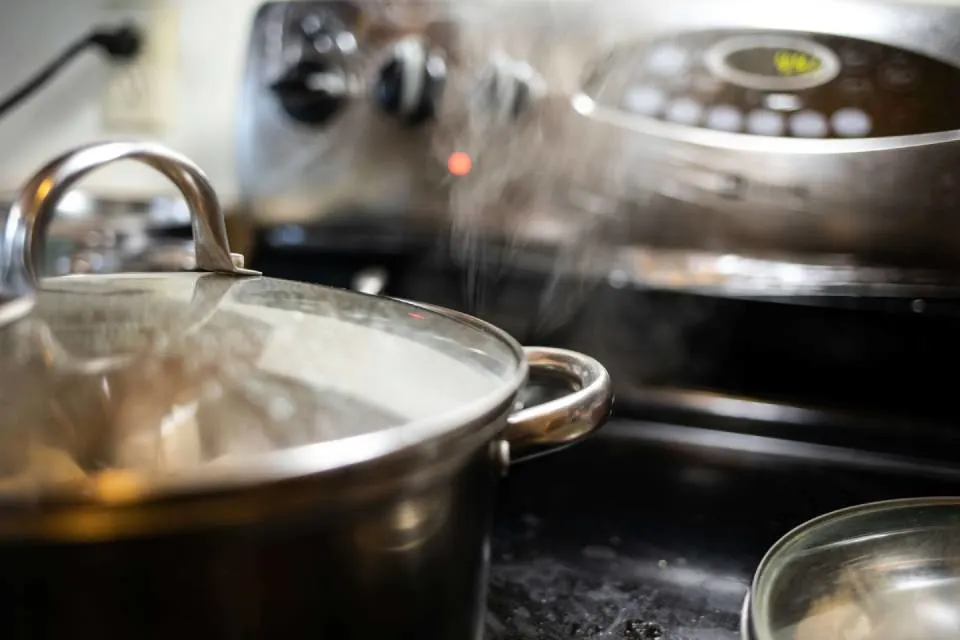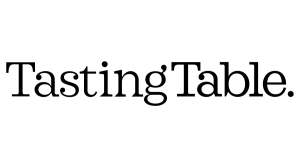
Discover the secret behind irresistibly soft, long-lasting bread with Tangzhong, an ancient Asian baking technique. This method, gaining popularity worldwide, involves cooking a portion of the flour and liquid from the bread recipe to create a smooth paste. This simple yet transformative step results in bread that stays soft and fresh for days, revolutionizing traditional baking practices. Join us as we explore the wonders of Tangzhong baking.
TL;DR
- Tangzhong, or water roux, is a Japanese method transforming bread texture.
- It’s gaining global popularity for producing moist, fluffy loaves.
- Perfect for various bread types, including sourdough brioche.
- Vegan-friendly versions of Tangzhong are available.
- Enhances bread’s shelf life without preservatives.
What Exactly is Tangzhong?
Tangzhong, a cornerstone of modern baking innovation, is also known as water roux. Originating from Japan, this technique has gained widespread popularity, particularly in Asian bread-making. It involves cooking approximately 5-10% of the total flour in your bread recipe with water or milk. This mixture is heated to 65°C (149°F), a critical temperature where the magic happens. At this point, the flour’s starches begin to gelatinize, transforming into a smooth, sticky paste. This seemingly small step fundamentally changes the flour’s properties, leading to a remarkable improvement in the final bread’s texture.
The Science Behind Tangzhong
The effectiveness of Tangzhong lies in its scientific foundation. When the starches in the flour gelatinize, they undergo a structural change, allowing them to absorb and retain more water – up to twice their weight. This increased water retention is crucial. During the baking process, the gelatinized starches release moisture gradually. This slow release ensures that the bread remains exceptionally soft, tender, and fluffy. Additionally, this moisture retention inhibits staling, meaning your bread stays fresh and delectable for a longer period, often up to several days after baking.
Moreover, Tangzhong affects the bread’s crumb structure. Breads made with this method typically have a finer, more uniform crumb, which contributes to their soft texture. This technique is particularly beneficial for enriched breads, like brioche or Hokkaido milk bread, where a tender, luxurious texture is desired.
Transforming Breads Across the Globe
The Tangzhong method has revolutionized bread-making on a global scale, as noted by Michelle Lopez, the acclaimed author of “Weeknight Baking.” She eloquently states, “The secret to softer, fluffier, more pillowy breads lies not just in kneading or proofing but also in Tangzhong.” This insight highlights the profound impact Tangzhong has had across diverse culinary cultures. From the bustling bakeries of Paris to the cozy kitchens in Tokyo, bakers around the world have embraced Tangzhong, integrating it into a wide array of bread recipes. This technique has become a unifying thread in the global baking community, celebrated for its ability to enhance bread quality, transcending traditional baking methods and cultural boundaries.
Tangzhong and Its Versatility
The true allure of Tangzhong is its remarkable versatility. This technique is not confined to any single type of bread; it can be seamlessly incorporated into various recipes, transforming the texture and shelf life of each. Whether it’s a classic white loaf, rustic whole grain bread, or delicate pastries, Tangzhong can be the key to achieving that elusive, perfect texture.
For instance, when applied to dinner rolls, Tangzhong imparts a melt-in-your-mouth tenderness, making them an irresistible accompaniment to any meal. In the realm of sourdough, where the crumb’s texture is paramount, Tangzhong elevates the standard sourdough brioche. It enriches the brioche’s inherent richness, yielding a product that is both luxuriously soft and deeply flavorful. This has made Tangzhong particularly popular among artisan bakers, who constantly seek ways to refine and enhance their bread.
Moreover, Tangzhong’s adaptability extends to various dietary preferences and needs. It can be used in recipes requiring dairy-free or vegan ingredients, ensuring that the joys of soft, fluffy bread are accessible to a wider audience. This inclusivity further underscores the method’s global appeal.
A Vegan Twist on Tangzhong
Tangzhong’s adaptability shines brightly when it comes to accommodating dietary restrictions, particularly for those following a vegan lifestyle. The traditional Tangzhong recipe calls for water or milk, but it can be effortlessly modified by substituting dairy milk with a variety of plant-based alternatives. Almond, soy, oat, and coconut milk are excellent choices, each bringing its unique flavor and nutritional profile to the bread. These vegan-friendly milks work seamlessly in the Tangzhong method, ensuring that the resulting bread retains the signature softness and fluffiness.
Moreover, for those avoiding animal products, the rest of the bread recipe can be easily adapted. Vegan butters and egg substitutes can replace their animal-derived counterparts without compromising the bread’s quality. This flexibility allows vegan bakers to explore a wide range of bread types, from classic loaves to sweet buns, all while adhering to their dietary preferences.
Why Tangzhong is a Trend Worth Following
The burgeoning popularity of Tangzhong among home bakers is a testament to its effectiveness and simplicity. This method addresses a common challenge in bread making: retaining moisture without resorting to artificial preservatives. By gelatinizing the starch in the flour, Tangzhong naturally extends the bread’s freshness and softness. This not only enhances the eating experience but also aligns with a growing preference for healthier, preservative-free baking. Additionally, the method’s ability to produce consistently high-quality results has made it a favorite among both novice and seasoned bakers.
Personal Insights and Tips
Drawing from my extensive experience as a journalist, I’ve observed the transformative impact of this method on various bread recipes. One crucial tip for success with Tangzhong is patience. It’s vital to let the Tangzhong mixture cool completely before incorporating it into your dough. This ensures the proper hydration of the flour and prevents premature yeast activation, which can affect the dough’s rise and texture.

Experimentation is another key aspect of mastering Tangzhong. Don’t hesitate to try it in different bread types and with various flour combinations. Each variation can lead to new and exciting textures and flavors. Remember, Tangzhong is not just a technique; it’s a gateway to a world of creative and satisfying bread-making.
Conclusion
In conclusion, Tangzhong is a remarkable baking technique that has revolutionized the way we think about bread. Originating from Japan, this method has crossed oceans and cultural barriers, bringing a unique softness and longevity to bread that was once thought impossible without preservatives. Its simplicity and effectiveness in enhancing the texture and shelf life of bread make it a valuable tool for bakers of all levels.
The versatility of Tangzhong is one of its most compelling attributes. It can be adapted for a wide range of bread types, from classic loaves to luxurious sourdough brioche, and even accommodates dietary preferences such as veganism. By substituting dairy with plant-based milks, Tangzhong remains accessible and relevant to a diverse audience.
The growing popularity of Tangzhong among home bakers is a testament to its practicality and the delightful results it yields. It’s a healthier, more natural way to enjoy bread that stays moist and fluffy for days. As an experienced journalist in this field, I’ve witnessed the transformative effects of Tangzhong on various bread recipes. The key to success with this method is patience, particularly in allowing the Tangzhong to cool, and a willingness to experiment with different recipes and ingredients.
Whether you’re a novice or a seasoned baker, incorporating Tangzhong into your baking repertoire can elevate your bread to new heights of texture and flavor. It’s a trend that’s not only worth following but also embracing, as it represents the perfect blend of culinary tradition and modern innovation.
FAQs
What is Tangzhong?
Tangzhong is a Japanese bread-making technique involving cooking a portion of the flour and liquid into a paste, resulting in softer, fluffier bread.
What is the difference between tangzhong and Yudane?
Tangzhong involves cooking a portion of the flour with water or milk to create a roux, while Yudane involves mixing boiling water directly with flour. Both methods enhance the softness and shelf life of bread, but they achieve this through slightly different processes.
What do you use Tangzhong for?
It’s used to enhance the texture and shelf life of various breads, including loaves, rolls, and brioche.
Can you use it with sourdough bread?
Yes, Tangzhong works wonderfully with sourdough, especially in recipes like sourdough brioche, adding a soft texture.
Is there a vegan option?
Absolutely! You can make vegan Tangzhong using plant-based milks and other vegan-friendly ingredients.
Does Tangzhong make bread last longer?
Yes, bread made with Tangzhong tends to stay fresh longer due to better moisture retention.
Can it be used in all bread recipes?
While Tangzhong is versatile, it’s best suited for recipes where a soft, fluffy texture is desired.
Is Tangzhong difficult to make?
No, it’s quite simple! It involves cooking a mixture of flour and water or milk until it forms a thick paste.
Does Tangzhong change the flavor of bread?
Tangzhong primarily affects texture, not flavor, making breads softer and fluffier.
Can Tangzhong be made ahead of time?
Yes, you can prepare Tangzhong ahead of time and store it in the refrigerator for a few days.
Is Tangzhong suitable for gluten-free baking?
While traditional Tangzhong uses wheat flour, gluten-free alternatives can be experimented with for similar results.
Join Us and Transform >
Don’t Be an Amateur! Master the Art of Sourdough Bread!




Sandra, your recent blog post really resonated with me, especially the part about embracing change. Just like you, I’ve found that stepping out of my comfort zone often leads to incredible personal growth. Can you share any tips on how to conquer the fear that often accompanies change?
Also, I think it’s worth noting to other readers that change doesn’t always have to be dramatic or life-altering; small changes in our daily routines can also lead to significant shifts in our perspectives. For instance, something as simple as trying out a new cuisine opened my eyes to a whole new culture and ignited a passion for travel in me.
Does anyone have similar experiences to share? Isn’t it fascinating how seemingly insignificant changes can have such profound impacts on our lives? Let’s keep this discussion going! 😊🙌